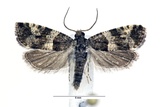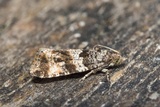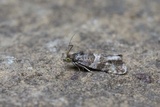Lobesia abscisana (Doubleday, [1849]) Species
Last modified: Nov. 22, 2025, 5:13 p.m.
A fairly common species, but mostly confined to the north of Belgium, in the southern provinces it is a rare species.
Details
- Classification
- Family: Tortricidae > Subfamily: Olethreutinae > Tribus: Lobesiini > Genus: Lobesia > Species: Lobesia abscisana
- Vernacular names
- Akkerdistelbladroller (NL), Smoky-barred Marble (EN), Kratzdistelwickler (DE)
- Synonyms
- Lobesia fuligana sensu auct., nec (Denis & Schiffermüller, 1775)
- First mention in Belgium
- Janmoulle E. 1947a. Espèces nouvelles pour la faune belge. — Lambillionea 47(1–2): 2, 27, 57. On page 2.
- Status
-
Native
Distribution
Imago
Wingspan 10–13 mm. A smallish species with a light grey or light ochre forewing with dark brown or fuscous markings. There is a well defined basal patch, a central fascia and a patch on the middle of the termen that extends to pre-apex. The central fascia may join a pre-tornal spot. The central band has a small extension in the middle of its posterior edge that is usually darker.
Bionomics
The larva feeds in the shoots on the food plant. Pupation takes places in a cocoon, spun amongst surface litter.
The adults come to light.
Flight periods
The moth has two or three generations in a year and may be found from April till September.
Observed on
- Host plant (species):
- Cirsium arvense
The larva lives on Cirsium arvense.
Habitat
It inhabits open and rural areas.




